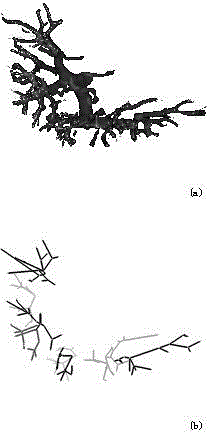Liver Image Segmentation Method Based on Hierarchical Vascular Tree Division
A liver segmentation and vascular tree technology, applied in image analysis, image data processing, instruments, etc., can solve problems such as large amount of calculation, parameter self-adaptive adjustment, influence, etc. great effect
- Summary
- Abstract
- Description
- Claims
- Application Information
AI Technical Summary
Problems solved by technology
Method used
Image
Examples
Embodiment 1
[0018] Example 1: Refer to the attached drawings, in figure 1 A flow chart of the method of the present invention is given in, and a set of embodiments are given according to the illustrated flow. This method first uses a directed tree G=(V, E) to represent the topological structure of the hepatic portal vein vessels, and then according to the spatial distribution of the hepatic portal vein vessels in the specific case images and the average branch radius information, the vessel classification parameters are determined and the hierarchical vessel tree is constructed T 1 And T 2 , Mark the secondary subtree set T that supplies the liver ’ , Divide the marked secondary subtree into eight types according to the blood supply area ’ ={C 0 ,...,C 8 }, and then use the shortest distance algorithm to divide the liver into eight liver segments L={L 0 ,...,L 8 } And perform interpretation and visualization.
[0019] in figure 2 In the illustrated embodiment, figure 2 (a) is the liver ...
PUM
 Login to View More
Login to View More Abstract
Description
Claims
Application Information
 Login to View More
Login to View More - R&D
- Intellectual Property
- Life Sciences
- Materials
- Tech Scout
- Unparalleled Data Quality
- Higher Quality Content
- 60% Fewer Hallucinations
Browse by: Latest US Patents, China's latest patents, Technical Efficacy Thesaurus, Application Domain, Technology Topic, Popular Technical Reports.
© 2025 PatSnap. All rights reserved.Legal|Privacy policy|Modern Slavery Act Transparency Statement|Sitemap|About US| Contact US: help@patsnap.com



